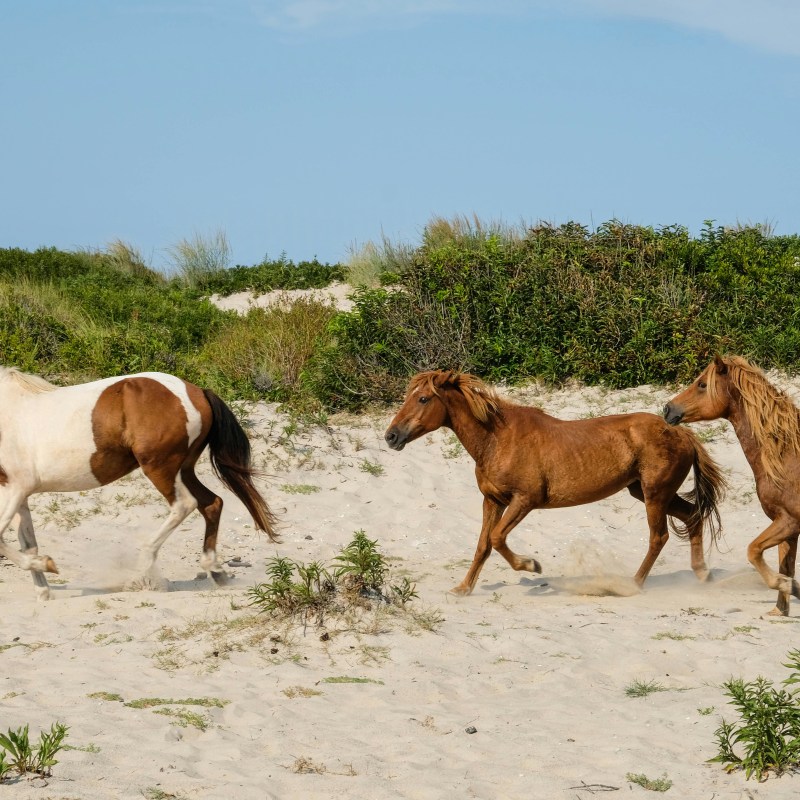
Wild horses and ponies can be found across the United States.
Videos by TravelAwaits
You might know these wild populations mustangs—a term used to describe feral horses that were once domesticated.
Bands of mustangs roam dozens of states. From Georgia to Arizona to Oregon, these mustangs have traded in their saddles and bridles for freedom.
All bands have descended from the horses brought over during European settlement… and some wild mustangs can even trace their ancestry back to a single event.
Enter Assateague Island (also known as Chincoteague, but we’ll get to that later).
The mustangs on Assateague Island can trace their ancestry back to a Spanish galleon that sank in the early 1500s. Centuries later, these feral bands still roam a magical, 37-acre stretch of island in the Atlantic.
Enter the wild ponies of Chincoteague… also known as the feral horses of Assateague.
Don’t worry. It’s not as complicated as it sounds.
The island with two names
This island sits off the coast of Ocean City, Maryland. It’s divided between the states of Virginia and Maryland, which is why it’s known by two names.
Maryland is responsible for two-thirds of the island, while its southern portion belongs to Virginia.
In Maryland, it’s called Assateague—and its home to feral horses.
In Virginia, its known as Chincoteague—and it’s home to wild ponies.
Can’t figure out the difference between horses and ponies? It’s about height. Ponies are short. That’s it.
Now onto the good stuff, like how you can get your eyes on these Spanish-American mustangs and what other experiences are worth your time on this island.
I’m breaking down my recommendations based on location, as this little island is run by three distinct authorities.
Assateague State Park (Maryland)
The northernmost part of the island is Assateague State Park.
The most popular entrance to Assateague is via the bridge from Berlin, Maryland. Keep in mind that there’s no road that runs down the island, which means you’ll need to exit if you want to explore the southern Virginian portion.
When you enter Assateague State Park, you’ll find a two-mile stretch of beautiful Atlantic coast. It’s a hot spot for locals during the summer months, but it’s open year-round.
During the warmer months, parasailing is a popular activity—assuming the winds allow it. There’s also a well-equipped camping ground that’s open to the public from April until October. Pets are selectively allowed, as this island has an extensive wildlife refuge area.
But you’ll have the benefit of some pretty solid camping amenities, including RV and camper hook-ups and warm water in the shower rooms.
Assateague Island National Seashore (Maryland)
This portion of the island is regulated by the National Park Service.
Here is where you’ll find the island’s wild ponies—assuming you can get close enough. Cars are only allowed in certain parts of the NPS-regulated park.
Ponies aside, you’ll be able to enjoy the beach and swim, go fishing, explore the hiking trails on foot or via bicycle, and rent kayaks.
Renting kayaks is hugely popular when it comes to spotting wild ponies; they’re less prone to flee kayaks than people on foot.
You can also camp here, including hookups for campers and RVs. But the sites are lot more rustic than the other two. So, if you’re on the hunt for hot water for your showers, it’s best to stay elsewhere.
Chincoteague Wildlife Refuge (Virginia)
Remember what I said up top: it’s Chincoteague in Virginia and Assateague in Maryland.
While the Chincoteague National Wildlife Refuge has a different name, it’s in the same place. But, once more, you’ll need to enter from the Virginia entrance, as there’s no road that leads from the Assateague Island National Seashore to the Chincoteague Wildlife Refuge.
And like the title suggests, there’s no camping and the roads are limited. Visitors are allowed to enjoy the beach, explore the marshlands, and take to the water in kayaks.
It’s a hotspot for birdwatchers, too. Chincoteague plays an important role as a migratory stop for many birds, along with high-profile raptors like the Bald Eagle.
What’s with the horses and ponies?
Assateague Island is one of the best places to stalk wild horses.
The best option of the three listed above is the Assateague Island National Seashore area. Wildlife tours are common, including options for spotting birds and even seaflie.
But this spot is also where the horses hang out most often. They’re known to wander through campsites, nurse their foals on the roadsides, and wade into the water on warm days.
Guests are encouraged to stay at least 40 feet from the horses—and could be fined up to $100 for ignoring the rules.
Additionally, feeding the horses carrots, apples, and other treats is also a no-go—it could hurt their grass-eating tummies and give them colic.
But if you want to get closer to the pony action, you can head to the area during the July pony penning carnival. Chincoteague’s volunteer fire bridge regularly rounds up the ponies to drive them north. Just for fun, I think.
